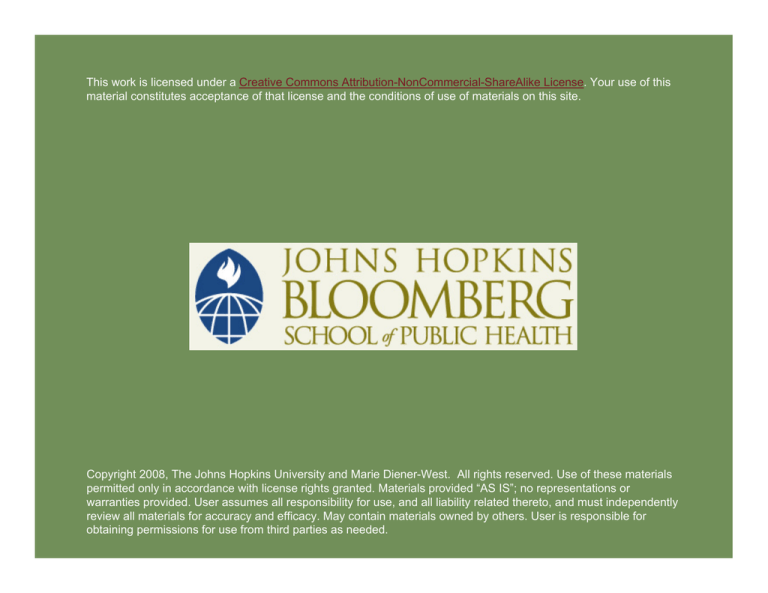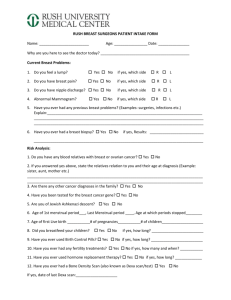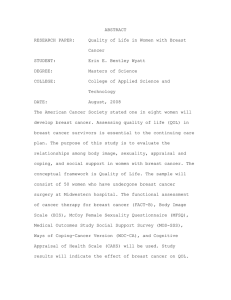
This work is licensed under a Creative Commons Attribution-NonCommercial-ShareAlike License. Your use of this
material constitutes acceptance of that license and the conditions of use of materials on this site.
Copyright 2008, The Johns Hopkins University and Marie Diener-West. All rights reserved. Use of these materials
permitted only in accordance with license rights granted. Materials provided “AS IS”; no representations or
warranties provided. User assumes all responsibility for use, and all liability related thereto, and must independently
review all materials for accuracy and efficacy. May contain materials owned by others. User is responsible for
obtaining permissions for use from third parties as needed.
Probability Concepts
Marie Diener-West, PhD
Johns Hopkins University
Section A
Definitions and Examples
What Is Probability?
Probability provides a measure of the uncertainty (or
certainty) associated with the occurrence of events or
outcomes
Probability is useful in exploring and quantifying relationships
4
What Do We Mean by “Probability of 1 in 14 Million”?
Winning the Maryland Lottery
Heads every time in 24 tosses of a coin
350 people in the world with a characteristic
17 people in the United States with a characteristic
5
Useful Set Notation and Definitions
A set is a collection of objects
The objects in a set are called the elements of the set
The joint occurrence of two sets (the intersection) contains
the common elements
Two sets are mutually exclusive if the sets have no common
elements
6
Intersection of Sets
The intersection of two sets, A and B, is another set which
consists of the common elements of both A and B (all
elements belonging to both A and B)
The intersection is the joint occurrence of A and B
Notation: A and B, A ∩ B
7
Example of an Intersection of Events
40 women (characteristic A)
30 individuals aged 30 or older (characteristic B)
Suppose we are told that there are 20 women aged 30 years
or older
The intersection of sets A and B is the set of 20 women aged
30 or older (A and B)
− The intersection is the joint occurrence of individuals who
are women and of age 30 years or older
8
Example of Mutually Exclusive Events
60 women aged 60 or older (characteristic A)
20 women aged less than 60 (characteristic B)
The intersection of the two sets, A and B, is empty because a
woman cannot belong to both age groups
Sets A and B are mutually exclusive (e.g., the two age groups
are mutually exclusive) because individuals cannot belong to
both age groups at the same time
9
Union of Sets
The union of two sets, A and B, is another set which consists
of all elements belonging to set A or to set B (or some may
belong to both sets)
Notation: A or B, A ∪ B
10
Example of a Union of Events
40 women (characteristic A)
30 individuals aged 30 or older (characteristic B)
The intersection of sets A and B is the set of 20 women aged
30 or over (A and B)
Sets A and B total to 70
− But 20 individuals are common to both sets
The union of sets A and B is the set of all individuals who are
women or aged 30
The union of the these two sets (A or B) consists of the 50
unique individuals who have one or both characteristics (A
alone or B alone or both A and B)
11
Intersections and Unions
If you have a group of 40 women
(set A)
c
c
c
c
c
c
c
c
c
c
c
c
c
c
c
c
c
c
c
c
c
c
c
c
c
c
c
c
c
c
c
c
c
c
c
c
c
c
c
c
And you have a group of 30 individuals
aged 30 or over (set B)
c
c
c
c
c
c
c
c
c
c
c
c
c
c
c
c
c
c
c
c
b
b
b
b
b
b
b
b
b
b
12
Intersections and Unions
The intersection of sets A and B are the 20 women who are aged 30 or
over
c
c
c
c
c
c
c
c
c
c
c
c
c
c
c
c
c
c
c
c
c
c
c
c
c
c
c
c
c
c
c
c
c
c
c
c
c
c
c
c
b
b
b
b
b
b
b
b
b
b
13
Intersections and Unions
If you have a group of 40 women
(set A)
c
c
c
c
c
c
c
c
c
c
c
c
c
c
c
c
c
c
c
c
c
c
c
c
c
c
c
c
c
c
c
c
c
c
c
c
c
c
c
c
And you have a group of 30 individuals
aged 30 or over (set B)
c
c
c
c
c
c
c
c
c
c
c
c
c
c
c
c
c
c
c
c
b
b
b
b
b
b
b
b
b
b
14
Intersections and Unions
The union of sets A and B is determined by adding up the total numbers
of each set . . .
c
c
c
c
c
c
c
c
c
c
c
c
c
c
c
c
c
c
c
c
c
c
c
c
c
c
c
c
c
c
c
c
c
c
c
c
c
c
c
c
c
c
c
c
c
c
c
c
c
c
c
c
c
c
c
c
c
c
c
c
b
b
b
b
b
b
b
b
b
b
Set A = 40
+ Set B = 30
Total = 70
15
Intersections and Unions
. . . And then subtracting out the individuals common to both sets
c
c
c
c
c
c
c
c
c
c
c
c
c
c
c
c
c
c
c
c
c
c
c
c
c
c
c
c
c
c
c
c
c
c
c
c
c
c
c
c
c
c
c
c
c
c
c
c
c
c
c
c
c
c
c
c
c
c
c
c
b
b
b
b
b
b
b
b
b
b
Set A = 40
+ Set B = 30
Total = 70
- Common = 20
Union: 50
unique
individuals
16
Classical Interpretation of Probability
An event occurs in N mutually exclusive and equally likely
ways
If m events possess a characteristic, E, then the probability of
the occurrence of E is equal to m/N
P(E) = m/N
17
Example of the Classical Interpretation of Probability
Flipping two fair coins (equal chances of obtaining a head or
a tail) results in N=4 equally likely and mutually exclusive
outcomes
E1 = HH, E2 = HT, E 3 = TH, E 4 = TT
The probability of each outcome is 1/4 or 0.25
P(E1 ) = P(E2 ) = P(E3 ) = P(E 4 ) = 0.25
18
Relative Frequency Interpretation of Probability
Some process or experiment is repeated for a large number of
times, n
If m events possess the characteristic, E, then the relative
frequency of occurrence of E, m/n will be approximately
equal to the probability of E
19
Example 1: Flip Two Coins 100 Times
Possible Outcomes
Frequency
E1 = HH
22
E2 = HT
28
E3 = TH
23
E4 = TT
27
Total
100
P(E1 ) = P(2 heads) is 0.25 using the classical interpretation of
probability
P(E1 ) is approximately 22/100 = 0.22 using the relative
frequency interpretation of probability
20
Example 2: Flip Two Coins 10,000 Times
Possible Outcomes
Frequency
E1 = HH
2,410
E2 = HT
2,582
E3 = TH
2,404
E4 = TT
2,604
Total
10,000
P(E1) = P(2 heads) is 0.25 using the classical interpretation of
probability
P(E1) is approximately 2,410/10,000 = 0.24 using the relative
frequency interpretation of probability
21
Rules of Probability with Mutually Exclusive Events
When there are n mutually exclusive events (cannot occur
together), the probability of any event is nonnegative
− P(Event i) ≥ 0
The sum of the probabilities of all mutually exclusive events
equals 1
− P(Event 1) + P(Event 2) +…+P(Event n) = 1
If Event i and Event j are mutually exclusive events, then the
probability of either Event i or Event j is the sum of the two
probabilities
− P(Event i or Event j ) = P(Event i) + P(Event j)
22
Addition Rule of Probability
General rule: if two events, A and B, are not mutually
exclusive, then the probability that event A or event B occurs
is:
− P(A or B) = P(A) + P(B) – P(A and B)
− P(A ∪ B) = P(A) + P(B) – P(A ∩ B)
Special case: when two events, A and B, are mutually
exclusive, then the probability that event A or event B occurs
is:
− P(A or B) = P(A) + P(B)
− P(A ∪ B) = P(A) + P(B)
since P(A and B) = 0 for mutually exclusive events
23
Joint Probability
The joint probability of an event A and an event B is
P(A ∩B) = P(A and B)
When events A and B are mutually exclusive, then
P(A and B) = 0
24
Conditional Probability
The conditional probability of an event A given an event B is
present is:
P(A I B)
P(A | B) =
where P (B) ≠ 0
P(B)
25
Multiplication Rule of Probability
General rule: the multiplication rule specifies the joint
probability as:
P(A I B) = P(B)P(A | B)
Special case: When events A and B are independent, then:
P(A |B) = P(A)
j
)
jB
A
P(AIB) = P(A)⋅ P(B)
26
Example: Relationship between Gender and Age
Patients with Disease X
Age
Gender
Young
Older
Total
Male
30
20
50
Female
40
110
150
Total
70
130
200
27
Marginal Probabilities Associated with the Example
Marginal probabilities can be calculated:
− P(Male) = 50/200 = 0.25
− P(Female) = 150/200 = 0.75
− P(Young) = 70/200 = 0.35
− P(Older) = 130/200 = 0.65
28
Probability of Selecting an Older Female?
Patients with Disease X
Age
Gender
Young
Older
Total
Male
30
20
50
Female
40
110
150
Total
70
130
200
Joint probability
− = P(Female and Older )= P( Female ∩ Older)
− = 110/200
− = 0.55
29
Probability of Selecting a Female or Older Individual?
Patients with Disease X
Age
Gender
Young
Older
Total
Male
30
20
50
Female
40
110
150
Total
70
130
200
By inspecting the table, we can see that the probability of
the union:
− P( Female or Older) = P(Female ∪ Older)
− = (40+110+20)/200 = 0.85
30
Probability of Selecting a Female or Older Individual?
Patients with Disease X
Age
Gender
Young
Older
Total
Male
30
20
50
Female
40
110
150
Total
70
130
200
Using the addition rule of probability:
− P( Female or Older)
− = P( Female) + P(Older) – P(Female and Older)
− = 150/200 + 130/200 – 110/200 = 170/200=0.85
31
Probability of Selecting a Younger Male?
Patients with Disease X
Age
Gender
Young
Older
Total
Male
30
20
50
Female
40
110
150
Total
70
130
200
Joint Probability
− = P( Male and Younger ) = 30/200 = 0.15
32
Probability of Selecting a Male or a Younger Individual?
Patients with Disease X
Age
Gender
Young
Older
Total
Male
30
20
50
Female
40
110
150
Total
70
130
200
By inspecting the table, we can see that the probability of
the union:
− P( Male or Younger) = (30+20+40)/200 = 0.45
33
Probability of Selecting a Male or a Younger Individual?
Patients with Disease X
Age
Gender
Young
Older
Total
Male
30
20
50
Female
40
110
150
Total
70
130
200
Using the addition rule of probability:
− P( Male or Younger)
− = P( Male) + P(Younger) – P(Male and Younger)
− = 50/200 + 70/200 – 30/200 = 90/200=0.45
34
Are Two Characteristics, Sex and Age, Independent?
Is sex independent of age in this group of patients?
If sex and age are independent:
− Then the probability of being in a particular age group
should be the same for both sexes
X In other words, the conditional probabilities should
be equal
Assess whether:
− P(Older given Male) = P(Older given Female) = P(Older)
− P(Older | Male) = P(Older |Female) = P(Older)
35
Conditional Probability for Males
Patients with Disease X
Age
Gender
Young
Older
Total
Male
30
20
50
Female
40
110
150
Total
70
130
200
P(Older given Male) = P(Older | Male) =20/50 = 0.40
36
Conditional Probability for Females
Patients with Disease X
Age
Gender
Young
Older
Total
Male
30
20
50
Female
40
110
150
Total
70
130
200
P(Older given Female) = P(Older | Female) =110/150= 0.73
37
Overall (Marginal Probability)
Patients with Disease X
Age
Gender
Young
Older
Total
Male
30
20
50
Female
40
110
150
Total
70
130
200
P(Older) = 130/200= 0.65
38
Comparing Conditional Probabilities
For males:
− P(Older | Male) = 0.40
For females:
− P(Older | Female) = 0.73
For all patients:
− P(Older) = 0.65
In this group of patients, age and sex are not independent
because the probability of being in the older age group
depends on gender!
− P(Older|Male) ≠P(Older | Female) ≠ P(Older)
39
Summary
Probabilities can describe certainty associated with an event
or characteristic
Types of events:
− Mutually exclusive events
− Independent events
Addition and multiple rules of probability
Types of probabilities:
− Marginal, joint, conditional
Future applications of probability (e.g. screening tests)
40
Section B
Using Probability in an Epidemiology Word Problem
Probability Word Problem
In a certain population of women:
− 4% have had breast cancer
− 20% are smokers
− 3% are smokers who have had breast cancer
From this problem, three probability statements may be
stated
A 2x2 table of cell counts and marginal totals can be
constructed
42
Probability Statement 1
4% have had breast cancer
P (breast cancer) = 0.04
Women with Breast Cancer
Smoker
Yes
No
Total
4
96
100
Yes
No
Total
43
Probability Statement 2
20% are smokers
P (smoker) = 0.20
Women with Breast Cancer
Smoker
Yes
No
Total
Yes
20
No
80
Total
4
96
100
44
Probability Statement 3
Three percent are smokers who have had breast cancer
P (breast cancer and smoker) = 3/100 = 0.03
Women with Breast Cancer
Smoker
Yes
Yes
No
3
20
No
Total
Total
80
4
96
100
45
Completing the 2 x 2 Table for Word Problem
Women with Breast Cancer
Smoker
Yes
No
Total
Yes
3
17
20
No
1
79
80
Total
4
96
100
46
Marginal Probabilities
P (breast cancer) = 0.04
P (no breast cancer) = 0.96
P (smoker) = 0.20
P (non-smoker) = 0.80
Women with Breast Cancer
Smoker
Yes
No
Total
Yes
3
17
20
No
1
79
80
Total
4
96
100
47
Question: Breast Cancer or Smoking? Method 1
What is the probability that a woman selected at random
from this population has had breast cancer or smokes?
Method 1: one can see from the table that:
− P(Breast Cancer or Smoker)
− = P(Breast Cancer ∪ Smoker)
− = (3+1+17)/100 = 0.21
Women with Breast Cancer
Smoker
Yes
No
Total
Yes
3
17
20
No
1
79
80
Total
4
96
100
48
Question: Breast Cancer or Smoking? Method 2
What is the probability that a woman selected at random
from this population has had breast cancer or smokes?
Method 2: using the addition rule:
− P(Breast Cancer or Smoker)
− = P(Breast Cancer) + P(Smoker) – P(Breast Cancer and
Smoker)
− = 0.04 + 0.20 – 0.03 = 0.21 = 21%
Women with Breast Cancer
Smoker
Yes
No
Total
Yes
3
17
20
No
1
79
80
Total
4
96
100
49
Answer: Breast Cancer or Smoking?
The probability that a woman has had breast cancer or
smokes is 0.21 or 21%
This probability may be derived from either:
− Inspection of the 2 x 2 table
− The probability statement
50
Question: Is Breast Cancer Independent of Smoking?
Is breast cancer independent of smoking in this population?
− In other words, is the probability of breast cancer the
same for both smokers and non-smokers?
Compare the separate (conditional) probabilities of breast
cancer for the two smoking groups
Women with Breast Cancer
Smoker
Yes
No
Total
Yes
3
17
20
No
1
79
80
Total
4
96
100
51
Comparing Conditional Probabilities of Breast Cancer
For smokers: P(Breast Cancer | Smoker) = 3/20=0.15
For non-smokers: P(Breast Cancer | Non-Smoker) = 1/80=0.01
For all women: P(Breast Cancer) = 4/100 = 0.04
Women with Breast Cancer
Smoker
Yes
No
Total
Yes
3
17
20
No
1
79
80
Total
4
96
100
52
Answer: Breast Cancer Is Not Independent of Smoking
In this group of patients, breast cancer and smoking are not
independent because the probability of having breast cancer
differs by smoking group
Semantics—it’s the same to say:
− “Breast cancer and smoking are not independent”
− “Breast cancer and smoking are dependent” (for
example, there appears to be an association
The probability of breast cancer is increased in smokers
P(Breast Cancer|Smoker) ≠P(Breast Cancer | Non-Smoker) ≠
P(Breast Cancer)
53
Other Questions?
What is the probability of having breast cancer? (marginal
probability)
What is the probability of being a smoker for a woman
without breast cancer? (conditional probability)
What is the joint probability of not smoking and not having
breast cancer? (intersection)
What is the probability of being a smoker or not being a
smoker? (union)
What is the joint probability of being both a smoker and a
non-smoker? (intersection)
54








